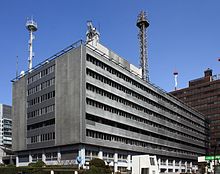Japanese Meteorological Agency
| Kishō-chō (気象庁?) | |

JMA logo
|
|
 JMA headquarters building in Tokyo |
|
| Agency overview | |
|---|---|
| Formed | July 1, 1956 |
| Preceding agencies |
|
| Jurisdiction | Government of Japan |
| Headquarters | 1-3-4 Ōtemachi, Chiyoda-ku, Tokyo 35°41′22.5″N 139°45′42.1″E / 35.689583°N 139.761694°ECoordinates: 35°41′22.5″N 139°45′42.1″E / 35.689583°N 139.761694°E |
| Employees | 5,539 (2010) |
| Annual budget |
¥62.0 billion (2010–11) ¥59.0 billion (2011–12) ¥58.9 billion (est. 2012) |
| Agency executives |
|
| Parent agency | Ministry of Land, Infrastructure, Transport and Tourism |
| Website | www |
The Japan Meteorological Agency (気象庁 Kishō-chō?), frequently abbreviated to JMA, is an agency of the Ministry of Land, Infrastructure, Transport and Tourism. It is charged with gathering and providing results for the public in Japan, that are obtained from data based on daily scientific observation and research into natural phenomena in the fields of meteorology, hydrology, seismology and volcanology, among other related scientific fields. Its headquarters is located in Chiyoda, Tokyo.
JMA is responsible for gathering and reporting weather data and forecasts for the general public, as well as providing aviation and marine weather. JMA other responsibilities include issuing warnings for volcanic eruptions, and the nationwide issuance of earthquake warnings of the Earthquake Early Warning (EEW) system. JMA is also designated one of the Regional Specialized Meteorological Centers of the World Meteorological Organization (WMO). It is responsible for forecasting, naming, and distributing warnings for tropical cyclones in the Northwestern Pacific region, including the Celebes Sea, the Sulu Sea, the South China Sea, the East China Sea, the Yellow Sea, the Sea of Japan and the Sea of Okhotsk.
...
Wikipedia
